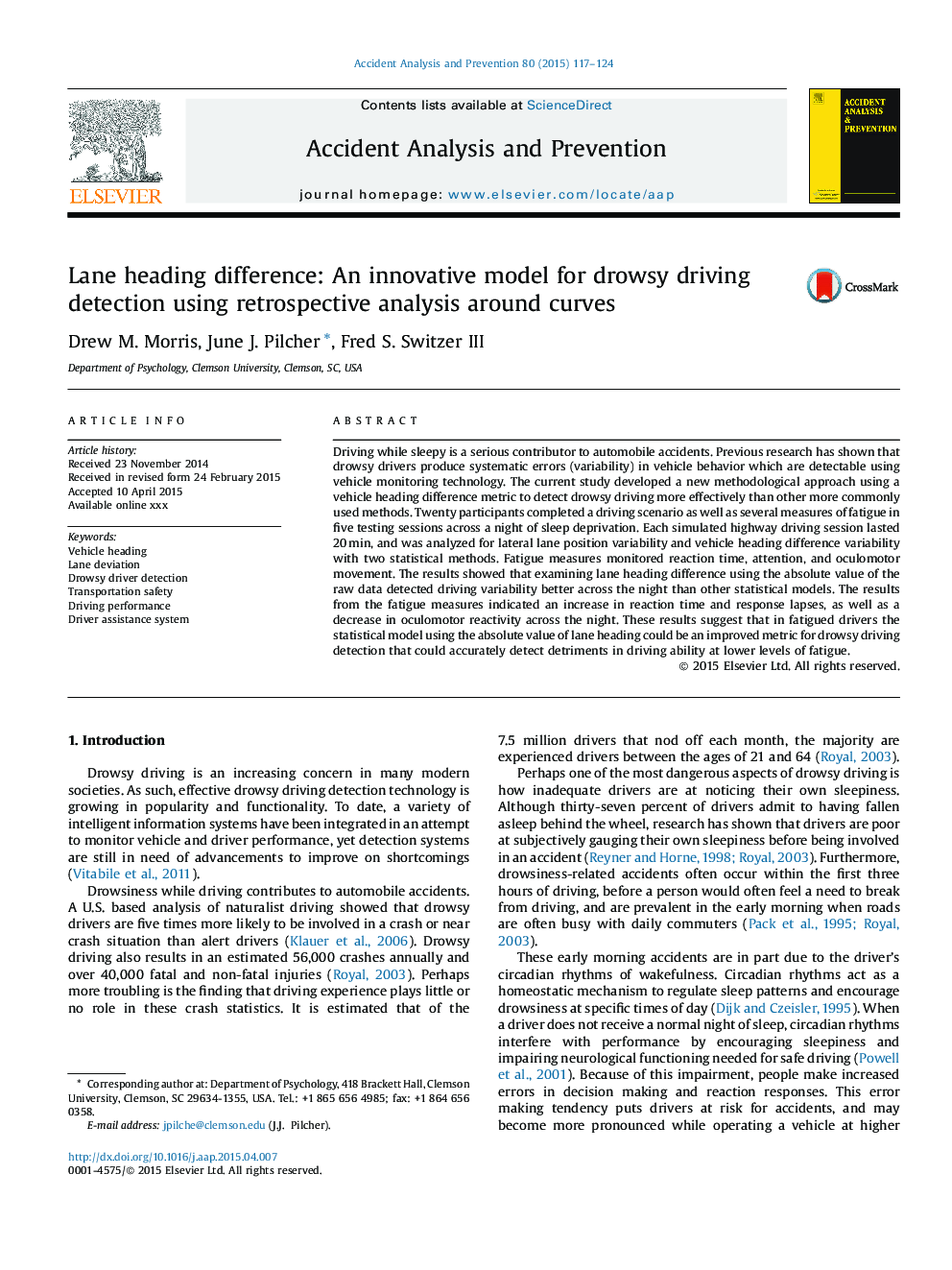| کد مقاله | کد نشریه | سال انتشار | مقاله انگلیسی | نسخه تمام متن |
|---|---|---|---|---|
| 6965645 | 1452917 | 2015 | 8 صفحه PDF | دانلود رایگان |
عنوان انگلیسی مقاله ISI
Lane heading difference: An innovative model for drowsy driving detection using retrospective analysis around curves
ترجمه فارسی عنوان
تفاوت خط عنوان: مدل نوآورانه برای تشخیص رانندگی سوسو با استفاده از تحلیل گذشته نگر در اطراف منحنی
دانلود مقاله + سفارش ترجمه
دانلود مقاله ISI انگلیسی
رایگان برای ایرانیان
کلمات کلیدی
عنوان خودرو، انحراف خط، تشخیص راننده خواب آلود، ایمنی حمل و نقل، عملکرد رانندگی، سیستم کمک درایور،
ترجمه چکیده
در حال رانندگی در حالی که خواب آلودگی جدی است، در حوادث خودرو موثر است. تحقیقات قبلی نشان داده است که رانندگان سرسخت خطاهای سیستماتیک (متغیر) را در رفتار وسایل نقلیه ایجاد می کنند که با استفاده از تکنولوژی مانیتورینگ خودرو قابل تشخیص است. در این مطالعه، روش جدید روش شناختی با استفاده از یک وسیله نقلیه در اختیار اندازه گیری قرار گرفت تا رانندگی خواب آلودگی را به طور موثرتری نسبت به سایر روش های معمول تر مورد استفاده قرار دهد. دوازده شرکت کننده یک سناریوی رانندگی و چندین روش خستگی را در پنج جلسه آزمایش در طول یک شب از محرومیت خواب به پایان رساندند. هر جلسه رانندگی شبیه سازی شده به مدت 20 دقیقه به مدت یک دقیقه و برای متغیرهای موقعیت لبه بالایی و متغیر اختلاف درجۀ خودرو با دو روش آماری تحلیل شد. اندازه گیری های خستگی، زمان واکنش، توجه و حرکات چشم را کنترل می کند. نتایج نشان داد که با استفاده از مقدار مطلق داده های خام، متغیر عنوان سریع در هر شب از شبیه سازی رانندگی نسبت به مدل های آماری دیگر بهتر است. نتایج حاصل از اقدامات خستگی نشان دهنده افزایش زمان واکنش و واکنش واکنش، و نیز کاهش واکنش چشم در شب است. این نتایج نشان می دهد که در راننده های خسته، مدل آماری با استفاده از ارزش مطلق عنوان مسیر می تواند یک متریک بهبود یافته برای تشخیص رانندگی مرسوم باشد که می تواند به طور دقیق در معرض آسیب های رانندگی در سطوح پایین خستگی قرار گیرد.
موضوعات مرتبط
مهندسی و علوم پایه
مهندسی شیمی
بهداشت و امنیت شیمی
چکیده انگلیسی
Driving while sleepy is a serious contributor to automobile accidents. Previous research has shown that drowsy drivers produce systematic errors (variability) in vehicle behavior which are detectable using vehicle monitoring technology. The current study developed a new methodological approach using a vehicle heading difference metric to detect drowsy driving more effectively than other more commonly used methods. Twenty participants completed a driving scenario as well as several measures of fatigue in five testing sessions across a night of sleep deprivation. Each simulated highway driving session lasted 20Â min, and was analyzed for lateral lane position variability and vehicle heading difference variability with two statistical methods. Fatigue measures monitored reaction time, attention, and oculomotor movement. The results showed that examining lane heading difference using the absolute value of the raw data detected driving variability better across the night than other statistical models. The results from the fatigue measures indicated an increase in reaction time and response lapses, as well as a decrease in oculomotor reactivity across the night. These results suggest that in fatigued drivers the statistical model using the absolute value of lane heading could be an improved metric for drowsy driving detection that could accurately detect detriments in driving ability at lower levels of fatigue.
ناشر
Database: Elsevier - ScienceDirect (ساینس دایرکت)
Journal: Accident Analysis & Prevention - Volume 80, July 2015, Pages 117-124
Journal: Accident Analysis & Prevention - Volume 80, July 2015, Pages 117-124
نویسندگان
Drew M. Morris, June J. Pilcher, Fred S. Switzer III,
